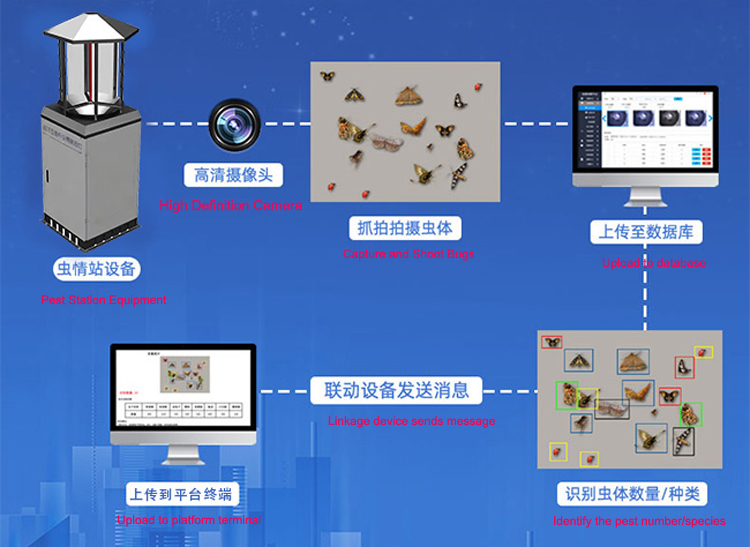

— Case —
—Products—
 Consumer hotline +8618073152920
Consumer hotline +8618073152920 WhatsApp:+8615367865107
Address:Room 102, District D, Houhu Industrial Park, Yuelu District, Changsha City, Hunan Province, China
Time:2022-07-31 11:30:27 Popularity:687
As the process of agricultural modernization advances, smart agriculture has gradually become an important tool to improve production efficiency, reduce resource waste, and enhance crop health management. Meteorological stations and pest monitoring systems, as core technological tools in modern agriculture, integrate advanced IoT technologies to provide precise environmental monitoring and pest alerts, greatly improving the efficiency of agricultural management and decision-making.
The meteorological monitoring system installed on farms includes several key components to ensure real-time and accurate monitoring of the farm’s environmental conditions. Common sensors in the system include wind speed sensors, wind direction sensors, and atmospheric temperature and humidity sensors, which effectively collect meteorological data closely related to crop growth. The atmospheric temperature and humidity sensors are typically equipped with a radiation shield to avoid direct sunlight, ensuring the accuracy of measurements.
Additionally, the meteorological system includes data collection and transmission terminals, which wirelessly transmit the collected data to a cloud platform for processing and analysis. The solar power supply system ensures a stable power source for the entire meteorological station, allowing it to operate continuously. To withstand various harsh weather conditions, the system is also equipped with protective boxes and lightning protection devices to safeguard the equipment from natural disasters. The coordinated operation of all these devices provides farmers with comprehensive meteorological data support, assisting them in making scientific agricultural decisions.

As part of the agricultural IoT, the intelligent pest monitoring system employs modern optical, electrical, and numerical control technologies combined with wireless transmission technology to achieve real-time pest monitoring and early warning. The system automatically collects pest information using sensors and transmits the data wirelessly to a monitoring platform. Farm managers can access real-time pest status from any location at any time via the internet.
The advantage of this system lies in its efficiency and automation. Compared to traditional manual inspection methods, the IoT pest monitoring system can monitor pests in the farmland 24/7, significantly reducing labor and time costs. Through real-time monitoring, farmers can detect pest outbreaks early and take timely measures based on the pest types, numbers, and distribution, preventing significant damage to crops.

With the continuous development of IoT technology, meteorological and pest monitoring systems will become even more intelligent and automated. Through more precise data collection and analysis, farmers will be able to implement more refined agricultural management. For example, by combining meteorological data and pest data, the system can predict future weather changes and pest outbreak trends, alerting farmers to take preventive measures, reduce pesticide use, and protect the growing environment and ecological balance of crops.
Overall, the IoT-based smart meteorological and pest monitoring systems provide precise data support for modern agriculture, helping farmers achieve scientific planting and management. These systems not only improve agricultural production efficiency but also contribute to sustainable agriculture and environmental protection. With technological advancements, future agriculture will be smarter, greener, and more sustainable.
The monitoring system of the weather station installed on the farm includes: wind speed sensor + wind direction sensor + atmospheric temperature and humidity sensor (including louver box) + data acquisition and transmission terminal + solar power supply system + mounting bracket + protective box + lightning protection device + Internet of things remote insect monitoring system .
The Internet of Things intelligent pest monitoring is a new generation of automatic pest monitoring and reporting system. This system mainly uses modern optical, electrical, numerical control technology, wireless transmission technology, and Internet technology to build a pest ecological monitoring and early warning system.
Related recommendations
Sensors & Weather Stations Catalog
Agriculture Sensors and Weather Stations Catalog-NiuBoL.pdf
Weather Stations Catalog-NiuBoL.pdf
Related products
 Combined air temperature and relative humidity sensor
Combined air temperature and relative humidity sensor Soil Moisture Temperature sensor for irrigation
Soil Moisture Temperature sensor for irrigation Soil pH sensor RS485 soil Testing instrument soil ph meter for agriculture
Soil pH sensor RS485 soil Testing instrument soil ph meter for agriculture Wind Speed sensor Output Modbus/RS485/Analog/0-5V/4-20mA
Wind Speed sensor Output Modbus/RS485/Analog/0-5V/4-20mA Tipping bucket rain gauge for weather monitoring auto rainfall sensor RS485/Outdoor/stainless steel
Tipping bucket rain gauge for weather monitoring auto rainfall sensor RS485/Outdoor/stainless steel Pyranometer Solar Radiation Sensor 4-20mA/RS485
Pyranometer Solar Radiation Sensor 4-20mA/RS485
Screenshot, WhatsApp to identify the QR code
WhatsApp number:+8615367865107
(Click on WhatsApp to copy and add friends)